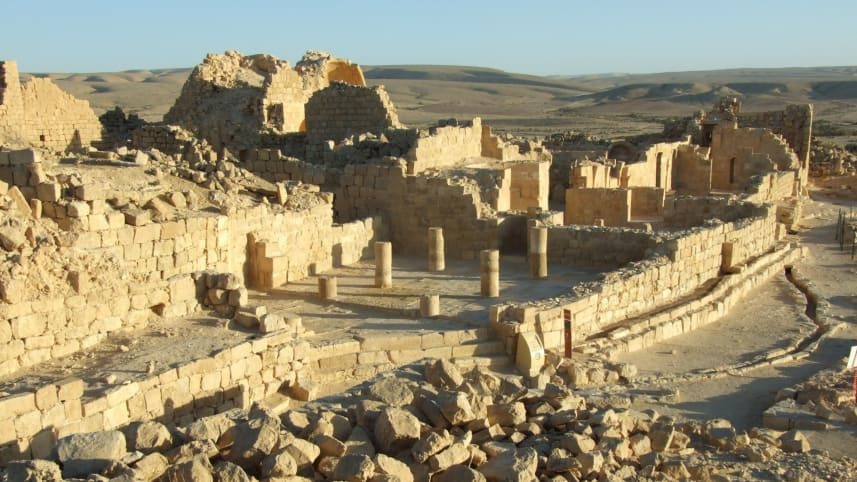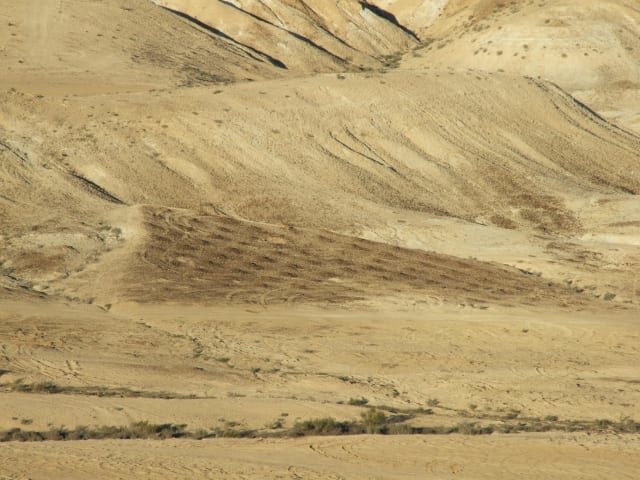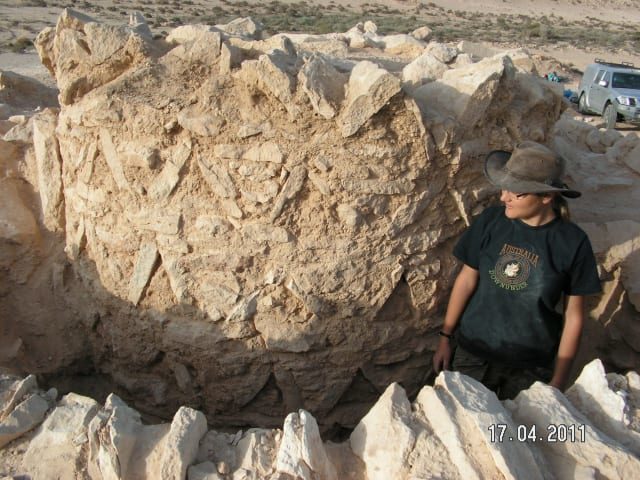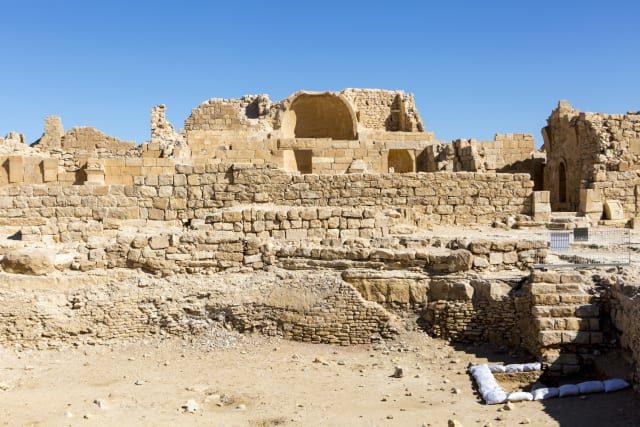
By the early Byzantine era, which began in 324 C.E., the farmers were flourishing by dint of remarkable water management and by strategically locating towering dovecotes in agricultural fields. The people grew olives, grapes and subsistence crops in the nutrient-poor loess soil, literally fertilized by the birds' copious emissions.
And then they were gone. What happened to the ancient dryland farmers of the Negev and when it happened - before or after the advent of the early Islamic period - has been a mystery. Some have thought agriculture disappeared in the late Byzantine period, which ended in 638 C.E., while others thought it persisted well into the Islamic period, to the 10th or 11th century.
Now Israeli archaeologists Yotam Tepper and Guy Bar-Oz of the Zinman Institute of Archaeology at the University of Haifa with Naomi Porat of the Geological Survey believe they have cracked the puzzle, based on thorough dating of the entire agricultural system at one representative spot, the ancient village of Shivta.
Unfavorable circumstances combined to tip the balance against the ancient agriculturalists of Shivta and the Negev, they concluded. In the aftermath of this sort of perfect storm, some villages such as Nessana (aka Nitzana) hung on longer than others - well into the Islamic period. But ultimately all succumbed and the desert reverted to barren wasteland peopled by the odd nomadic group.
In the case of Shivta, the team concludes that agriculture began in the Roman period, in the 1st or 2nd century C.E., and that its collapse coincided with the end of the Byzantine rule and start of the Islamic period, as Tepper, Porat and Bar-Oz report in the Journal of Arid Environments. The abrupt political transformation was part of the problem, but far from the whole story.
Our understanding of our past depends greatly on finding evidence, dating it, and interpreting it, all of which engender many a heated debate in archaeological circles.
Shivta and the ancient farming settlements of the Negev have been under archaeological investigation for decades. The ruins at Shivta were first discovered in 1871 in the heart of the Negev, about 40 kilometers (25 miles) southwest of Be'er Sheva.
Subsequent research deduced that the town had been populated by early Christians: three churches have been found from the 5th and 6th centuries. One was even found to feature a wall painting possibly of a young Jesus. There is no evidence of a Jewish presence in the village.
Rainfall in the Negev can range from 50 to 100 millimeters (2 to 4 inches) a year, which is pretty miserable, and the soil is scanty and nutrient-poor. Why would anybody move to the Negev to farm in the first place? Possibly because more hospitable lands to the north of the Negev had become overcrowded.
To farm the desert, the locals built systems to harvest and preserve rain and floodwater (though Tepper observes that we don't know exactly how much rain fell in that area back then). They built stone mounds on slopes to enhance the soil and rain runoff to the fields below in the wadis. They also erected dams to catch the alluvial soil and floodwater in the fields, so the water wouldn't just flow to the sea, he observes.
The loess soil was enriched with dove droppings by building giant dovecotes smack in the center of the fields, enabling the desert farmers to grow enough grapes to export wine.
By the way, the early Christians of the Negev didn't invent manure as fertilizer. Subsistence agriculture - as opposed to haphazardly growing this or that to augment a hunter-gatherer diet - as well as animal domestication seem to have been "invented" in the Near East around 12,000 years ago and to have spread to Europe around 8,500 years ago.
The use of dung as fertilizer in Europe evidently began quite quickly. A study by University of Oxford researchers in 2013 demonstrated, using isotope analysis on remains of cereals and legumes, that the earliest manure fertilizer use in Europe at least was 8,000 to 4,400 years ago. (Agriculture spread slowly).
How the first farmers figured out that domesticated animal poop was beneficial for their crops is anybody's guess, but since they harvested by hand, they likely easily observed that where the animals did their business, the crops flourished.
In the Negev, hallmarks of intense farming have been found in the ancient desert settlements of Shivta, Avdat (Eboda), Mamshit (Mampsis), Nitzana (Nessana), Rehovot, Sa'adon, and Elusa, the team writes. Yet the extensive archaeological investigation of the region up to this point hadn't focused specifically on dating the timing of construction and abandonment of agricultural activities, Bar-Oz explained to Haaretz.
"The limited ... work conducted previously relied less on absolute dating and more on collecting [pottery] shards," he said.
There are all sorts of methods to date ancient finds, as Tepper elaborated: There's radiocarbon dating for organic remains, comparing pottery and construction styles with known ones, and more recently, optically stimulated luminescence, or OSL, a method usually used to date fossils in geological sediments.
Each method has its aficionados, advantages and margins of error. However, deducing when an agriculture field's use began and stopped, or the use of a terrace to farm, is a whole other kettle of fish.
The new research, which was supported by the European Research Council, relied on a dating method developed by coauthor Naomi Porat and OSL-dating of the soil. For this project the team concentrated on one area of between 40 to 50 dunams (10 to 13 acres) near a pigeon tower. The location contained all the elements of the ancient engineering system: dams and associated agricultural fields, a cistern and artificial stone mounds to channel the runoff from the surrounding hills.
"We adopted a minimal approach and decided to date one full agricultural system with all of its adjacent installations," Bar-Oz says. "The results of our work showed that the terraces, stone mounds, pigeon towers and agricultural towers are all from the same period, i.e., they are all parts of the same episode" - the 5th and 6th century C.E., or the Byzantine era. Agriculture in Shivta collapsed in the 7th century, the start of the Islamic period. "I believe that this is the main strength of our results," he adds.
The storm gathers
Why did it end there? That is speculative, but perhaps the ancient villages of the Negev were overwhelmed by a series of changes and disasters, the archaeologists suggest: a fatal convergence of circumstances.
One element was likely the political and cultural changes as the Christian overlords were supplanted by Muslim ones with different priorities. Previous research has indicated that the takeover was not entirely amicable: the early mosque in Shivta was built using repurposed stones from the churches.
Possibly markets for Shivta's agriculture produce dried up; church subsidies to the population, if any, might have too, since taxes collected from the Christian empire and sent to Constantinople (today's Istanbul) would have disappeared too. Under the new rulers, the taxes would have been sent to their own hubs of power in Cairo and Damascus, Tepper points out. Christian pilgrimage in the region could have also waned.
Earthquakes may have played a part too. Israel is riddled with crustal faults and there had been two powerful quakes in the 7th century: in September 634 C.E. and in early June 659 C.E.
If that weren't enough, what about the Justinian Plague? While archaeologists suggest that its gravity may have been massively overestimated, there is no question that the Black Death was out and about in the 6th century. It began in Egypt around the year 541 and spread to Israel, Europe and Western Asia, finally petering out only two centuries later, in about 750 - the early Islamic period.
Even if the spread and toll from the disease was wildly exaggerated by the surviving scribes at the time, cycles of epidemic for decades could have fatally weakened the village and its economy.
Completing the perfect storm of unfortunate circumstances was a change in the climate. Not climate change as we know it now - the industrial era and its intense pollution hadn't begun yet - but it was a climate crisis all the same.
The years 535 and 536 brought extreme cold to the northern hemisphere, the worst for 2,000 years, climatologists believe. Some call it the Late Antique Little Ice Age. Contemporaneous reports from Europe and South America describe shrouded skies, crop failures and famine, and weird weather extremes from droughts to blizzards.
Scholars more or less agree that a violent eruption caused a volcanic winter, but to this day there's no consensus which volcano was the culprit. Or maybe there were two eruptions. And how did all this affect the Negev?
Europe and the Middle East seem to have been afflicted by a strange "fog" during that time, that blocked out the sun for 18 months and was described by a number of ancient sources. Perhaps that unearthly fog involved volcanic ash.
What was the tipping point? "Even today, what evidence is there of the coronavirus?" Tepper asks. "Research, particularly archaeological, has difficulty putting a finger on collapse as a result of a plague. Viruses and bacteria are hard to find in the archaeological record."
Take our very point in time: There are more deaths from the coronavirus but also fewer from traffic accidents. What would archaeologists 2,000 years hence think? Could they correctly identify the pandemic?
"I think the collapse was due to a combination of causes. There typically isn't one reason why settlements collapse or are diminished," Tepper says, leaving aside vengeful marauding armies, for instance. The cultural and political changes were joined by a climatic event and disease, which may not have been as bad as we thought, but afflicted key cities of the time, such as Alexandria or Caesarea. "The result was a domino effect, which led to utter abandonment," he states.
Shivta is only one small place, but its fate attests to the decline in the Negev at the end of the early Christian period, the archaeologists declare. Some places soldiered on: Nessana for instance. "Even if there was a Christian community in Nessana in the 9th or 10th century - that doesn't mean the whole settlement was sustained in same manner," Tepper points out. "There are complexities that archaeology may not notice."










Comment: One of the driving factors to all the disasters mentioned in the article above, and recorded by many peoples of the time - although strangely absent from the article - are cometary events. For more see Pierre Lescaudron's: The Seven Destructive Earth Passes of Comet Venus
See also:
- New Light on the Black Death: The Cosmic Connection
- Plague and climate change devastated fading Byzantine empire
- Book Review: New Light on the Black Death by Mike Baillie
And check out SOTT radio's: